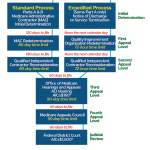
iQoncept/shutterstock.com
In its 2016 Work Plan, the HHS Office of Inspector General (OIG) outlined its plans for audits and evaluations of covered entities to work on creating a permanent and more structured audit program. In light of their focused effort, the Office for Civil Rights has indicated that they will concentrate on areas of high risk and non-compliance in the day-to-day practice of coding and billing.
As practices move forward in 2016, it is imperative to identify any areas of risk for non-compliance and where improvements should be made to correct any findings. Most practices will find that the highest area for risk lies in the billing area for services performed in the practice. It is not uncommon to bill incorrectly for a service, but the OIG usually makes the determination on whether a mistake is due to fraud or abuse, because incorrect billing can lead to significant overpayments. The key to avoiding and correcting any risk in billing is for a practice to conduct a series of audits on sampling of charts at least twice a year to monitor compliance. Reviewing billing and documentation requirements and applying them to services billed can help to identify and correct any problematic areas.
Implementing a self-audit program in the practice provides a great benefit to help with streamlining the day-to-day business operations. A practice’s self-audit program can be used to determine if:
- Bills are coded correctly and reflect the services provided that are documented in the medical records;
- Documentation is completed correctly; and
- Services provided are reasonable and necessary.
An ongoing evaluation of medical records will assist with taking a closer look at the standards and procedures for coding and billing, as well as review of claims submission. The standards and procedures for coding and billing in a practice should reflect the regulations as outlined in the procedural and diagnostic manuals in addition to all insurer policies and procedures.
It is recommended that practices start with a baseline audit; this will examine the claim development and submission process from the patient visit all the way through the claim submission and reimbursement. Taking a deep dive from the front end to the back end will help with identifying any element within the process that may contribute to non-compliance and may serve as a basis for future audits on specific areas in the practice. Although there are various ways to conduct a baseline audit, most auditors recommend that practices review high-dollar claims, high-volume procedures as well as key payers so as to give physicians a benchmark to measure on compliance and effectiveness. This should be done by randomly selecting five or more charts per payer. Audit results should be shared with the physician(s) as well as the billing and coding staff and incorporate any training and educational update as necessary.
In addition to the OIG 2016 Work Plan to improve its audit programs, an additional $350 million was provided by the Affordable Care Act to ramp up the Health Care Fraud and Abuse Control Program anti-fraud efforts, which includes increasing scrutiny of claims before payment, investing in sophisticated data analytics, and employing additional law enforcement agents. It is important for physician practices to pay close attention to the new rules written into the healthcare reform law, which made the Medicare and Medicaid screening and enrollment processes tighter, imposed stricter federal sentencing for fraud offenses, increased stronger civil and monetary penalties for violations, created a new requirement for providers to return overpayments to CMS within 60 days, and required that providers establish a fraud and abuse compliance program.
Practices should ensure that they are in compliance with the federal regulations and understand all the statutes as they relate to fraud and abuse. One of the most important components for a successful compliance audit protocol is training and education. Once a problem is identified, it will be essential for the physician and staff to know how to respond or determine the best course of action. In this effort, the ACR’s practice management department has developed a comprehensive compliance and audit program to assist rheumatology practices in how to implement a self-audit program. The ACR’s certified healthcare auditors will train staff on:
- Auditing and monitoring claims;
- Developing compliance procedures;
- Understanding and applying documentation standards;
- Responding to audit reports/letters and creating appeals letters; and
- Developing corrective action plans for the practice.
Although it is normal for the word audit to incite some feelings of fear and anxiety, with a greater level of understanding of the audit process, the uneasy emotion can be diminished. The key to auditing is to evaluate processes and identify any areas of weakness. The most important step in the world of audits is for physician practices to be proactive. Efforts should be made to ensure staff are educated and up to date with all audit practices and procedures, including what areas are being targeted.
Understanding how to manage and respond to appeals, denials and audit request forms is crucial to keeping rheumatology practices running smoothly and profitably. The ACR can assist you with reaching that goal through training and education. Contact the ACR certified healthcare audit instructors Antanya Chung, CPC, CPC-I, CRHC, CCP, and Melesia Tillman, CPC, CRHC, CHA, to set up a course in your area. Call 404-633-3777 or visit Rheumatology for additional information.


